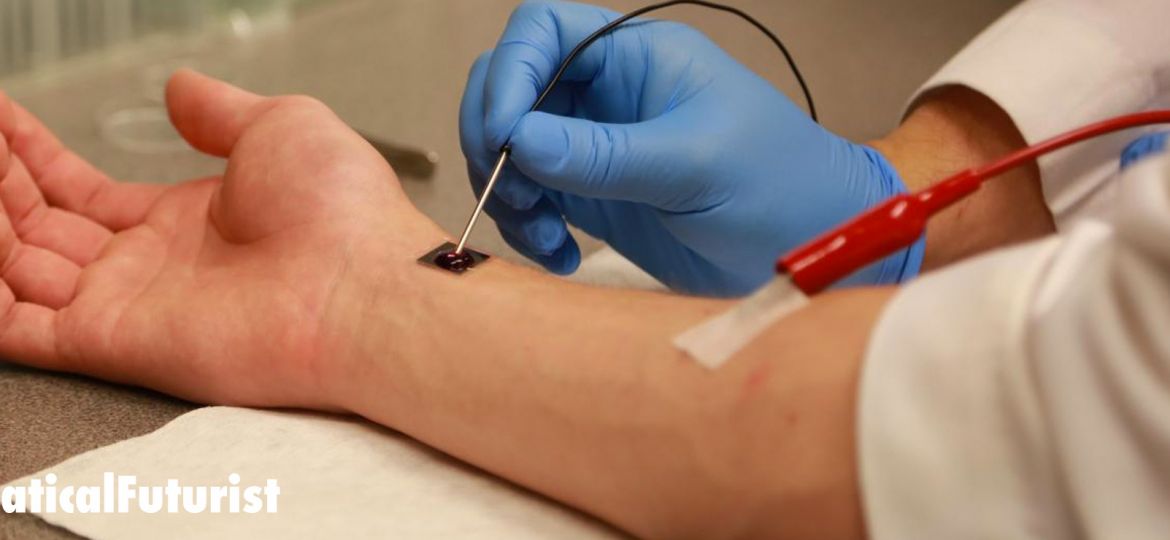
WHY THIS MATTERS IN BRIEF
- Tissue Nanotransference technology could help us heal organs quickly, and on demand, and put an end to the need for immunosuppressant drugs and the rejection of transplants
This week scientists from Ohio State University announced a “breakthrough” in Regenerative medicine, the field of healthcare research where scientists are trying to bring people back from the dead, and give us animal like superpowers that will help us regenerate any part of our bodies, in the same way as Starfish, Salamanders and Zebra fish do, on demand. The new non-invasive technology, unveiled this week, and dubbed Tissue Nanotransfection (TNT), is capable of re-growing damaged organs and healing serious wounds with nothing more than a touch from a small, coin sized pad.
TNT uses a combination of electric current and nanochips to re-programme skin cells and turn them into any cell doctors might need for a medical treatment, and the procedure takes less than a second to perform.
During recent laboratory trials the team used a small electric current to fire special, pre-programmed DNA into the skin cells of rats and pigs with damaged blood vessels in their legs that triggered them to convert themselves into the basic cellular building blocks of life, and help re-grow blood vessels, restore blood flow and, most importantly save their legs – all within just a couple of weeks. So far TNT has had a 98 percent success rate.
The team then also trialled the technology to see if it could help rats brain’s recover from strokes, and again the technology worked.
From a human perspective the new technology, which already follows on from a host of other recent sci-fi like advances such as 3D printed organs, cancer hunting nanobots, genetically engineered babies, and synthetic stem cells, to name just a fraction, could, eventually, once it passes the scrutiny of regulators, which is a long way off, usher in yet another revolution in healthcare.
For example, as strange as it sounds, TNT could help doctors grow human brain cells on a patients skin under the guidance of their its immune system, these cells could then be harvested and be injected into the patient’s brain to treat conditions like Alzheimers and Parkinsons disease, that thanks to another breakthrough patients might now be able to turn on and off, without the need for immunosuppression drugs – a revolution in itself.
And it doesn’t stop there, the technology could also be used to transform the chances of patients needing complicated reconstructive surgery, as well as those whose organs are prematurely ageing – speaking of which, one day it could join another host of anti-ageing technologies and be used as a weapon against ageing itself.
The researchers plan to start clinical trials on humans next year.
“With this technology, we can convert skin cells into elements of any organ with just one touch,” said Dr. Chandan Sen, who led the study, “this process only takes less than a second and is non-invasive, and then you’re off. The chip does not stay with you, and the reprogramming of the cell starts instantly.”
Unlike stem cell therapies, like the recent SkinGun that helps heal burns, TNT wouldn’t need any laboratory based procedures ahead of being used which, ultimately, means it could also be used in doctors and GP surgeries, and again, because the newly re-programmed cells are produced under the guidance of the host patients own immune system there wouldn’t be any need for immunosuppressant drugs when the new cells are transplanted, and as a result the likelihood of the new cells or organs being rejected is, arguably, zero.
“By using our novel nanochip technology, injured or compromised organs can be replaced,” said Dr Sen, “we have shown that skin is a fertile land where we can grow the elements of any organ that is declining.”
TNT extends the concept known as gene therapy, which has been known about for some time, but the big difference is how the DNA is delivered into the body.
“The concept is very simple,” said Professor James Lee, who co-led the research, “as a matter of fact, we were even surprised how it worked so well. In my lab, we have ongoing research trying to understand the mechanism and do even better. So, this is the beginning, more to come.”
The study is published in the journal Nature Nanotechnology.
















